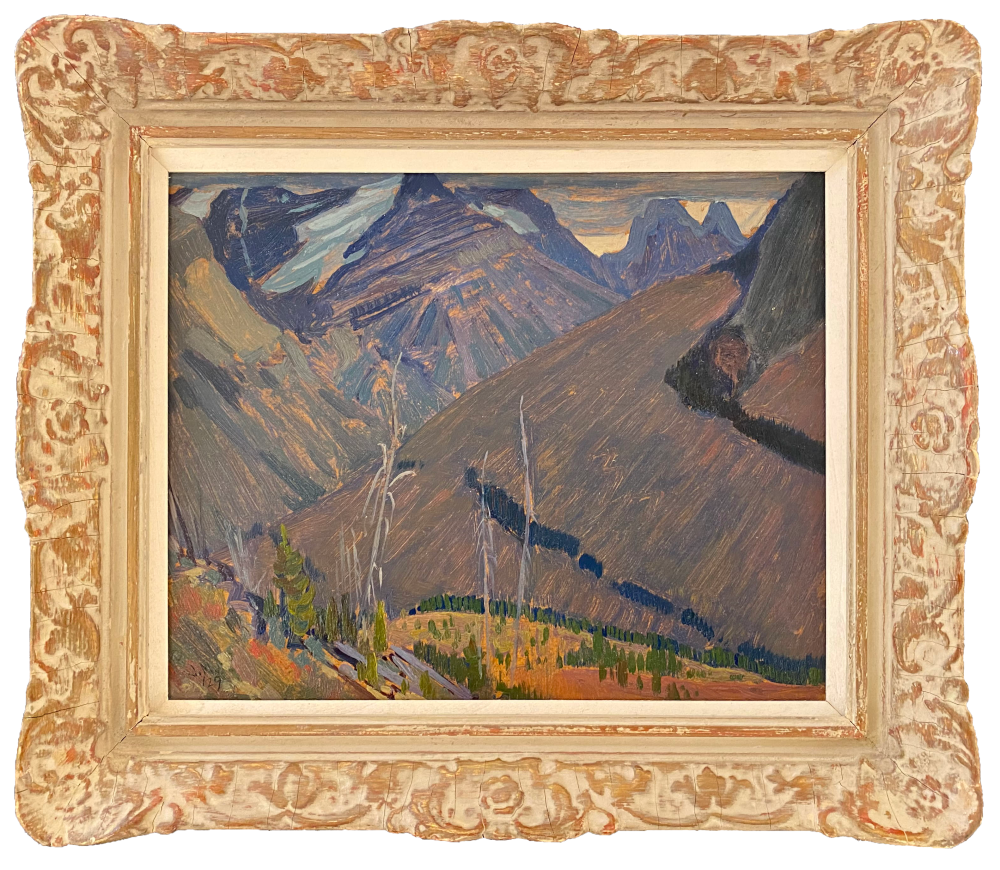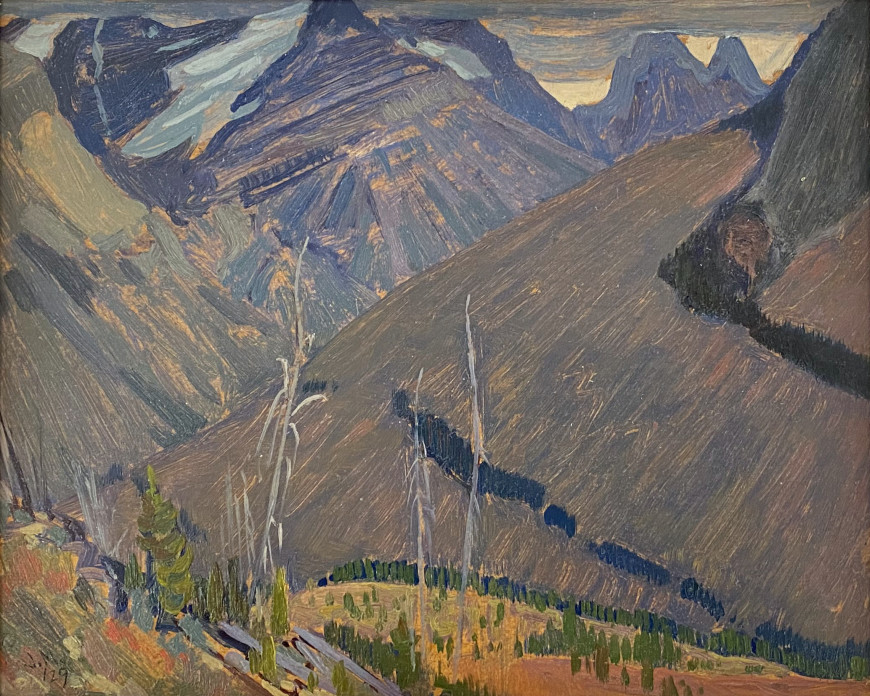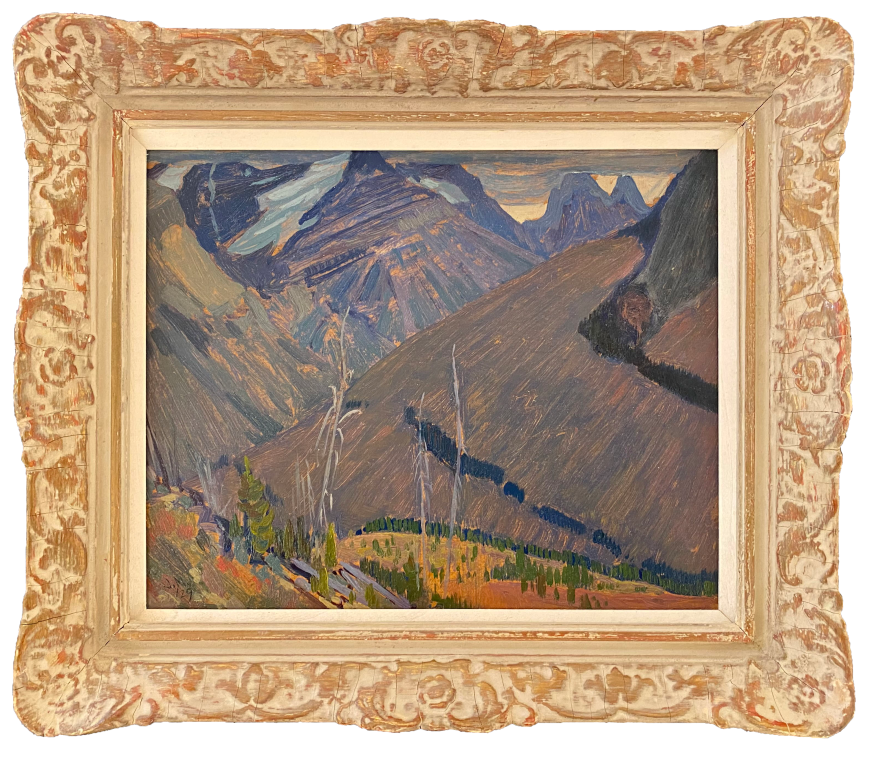-
Œuvres d'art
J.E.H. MacDonaldNear Wapta Lake, Kicking Horse Pass, Rocky Mountains, 19291873-1932Oil on panel8 1/2 x 10 1/2 in
21.6 x 26.7 cmSoldInscriptions
signed and dated ‘J.M. / ‘29' (lower left); inscribed by the artist, ‘Rainy weather / n. f. s.’ (verso, upper right) and titled and signed by the artist, ‘Near Lake Wapta. Kicking Horse / Pass / Rocky Mtn. / J.E.H. MacDonald’ (verso, upper right)Provenance
Roberts Art Gallery, Toronto;
Private collection, Montreal;
By descent to the present owners.
Far do you call me
Heavenly mountains
Lead my soul wandering
By your green fountains
Journal entry: March 19, 1927, J.E.H. MacDonald
During the years that J.E.H. MacDonald explored his beloved Lake O’Hara, in British Columbia’s Yoho National Park, he made full use of his time in order to execute as many studies as he possibly could while he was there. He painted in the summer twilight, from the shelter of overhanging rocks during rainstorms, and when he found himself with time on his hands along the way. After disembarking the train at Wapta Station, or when waiting for it after the eleven kilometre horse trip down the valley from Lake O’Hara proper to the station, he had sufficient time – on more than one occasion – to explore the mountain slopes at hand in the Kicking Horse Valley.
Here, we find him painting high on a slope above the valley floor, looking back towards the region he loved so deeply. He was in the vicinity of what is now the Paget Lookout when painting this work, the view looks over the shoulder of Mount Stephen on the right, with Narao Peak and a ridge of Mount Victoria at the centre-left and centre, respectively. Wapta Lake lies hidden in the steep valley below, out of view and off to the left. In the very far distance, peeking over Stephen’s shoulder, are two silvery-purple triangular peaks that seem to grab at the clouds and trail their summits through them. These are the blended summits of Mount Biddle and the Wiwaxy Peaks, peaks that cradle the Lake O’Hara region. A patch of brilliant sunshine glows from the dip between these summits and the ridge of Victoria, this would be shining on Lake O’Hara, MacDonald’s personal mountain mecca.
A bright, energetic, and quickly executed work, this study is additional proof of MacDonald’s ability to get up high. In his day, this vantage point would have required a rough scramble. The Paget Fire Lookout was built in the 1940s, used for that purpose until the 1970s, and is a day shelter today. MacDonald would not have had the nicely maintained trail that currently exist for hikers to gain this view when he was there in 1929. Yet he revelled in the scrambles that it took to attain unique views such as this one, they are a far cry from more easily reached views on established trails and along lakeshores. It was these off-trail adventures that served to bolster his sense of accomplishment and euphoria in the mountains, and underlie his attachment to the opportunities that presented themselves near Lake O’Hara.
MacDonald mentions sketching in the vicinity of the Wapta Lake train station several times in his journals, often with details that we might be able to link to a specific work. In these journals, which reside in the Library and Archives Canada holdings, he writes of painting “at bridge above Wapta” where the mountains made “fine silhouettes” and of capturing “Victoria lighter in tone than Narao”. We know he was near the Sherbrooke Lake trail head in 1929, painting a work called Poplars and Mountain Slopes (Private Collection). That same trail might have been the starting point for that scramble that resulted in Near Wapta Lake, Kicking Horse Pass, Rocky Mountains, painted the same year. Poplars and Mountain Slopes depicts a significant amount of snow on Narao Peak, further suggesting that they were done on different days on the 1929 trip – most probably, one at its beginning and the other at its end. Works such as these add significant detail to our understanding of MacDonald’s time in the mountains, and can tell us exactly where he was when we match them to the place they depict, compare the details in them, and plot MacDonald’s paintings on a map.
Near Wapta Lake, Kicking Horse Pass, Rocky Mountains, is a brightly executed work – despite the words “Rainy Weather“ that the artist has inscribed on its back. The golden bleached colours of autumn on the slope in the near-ground, and the sense of steepness in this wild mountain valley are faithfully rendered. The work speaks of autumnal heat and ripeness, of high alpine places, and of the nature of the wilderness, with its ever-changing weather, and the ravages of natural elements – we see skeletal burned trees in the near-ground. Above all, they are delightful statements about J.E.H. MacDonald’s love of the mountains of western Canada.
Lisa Christensen1sur 6













